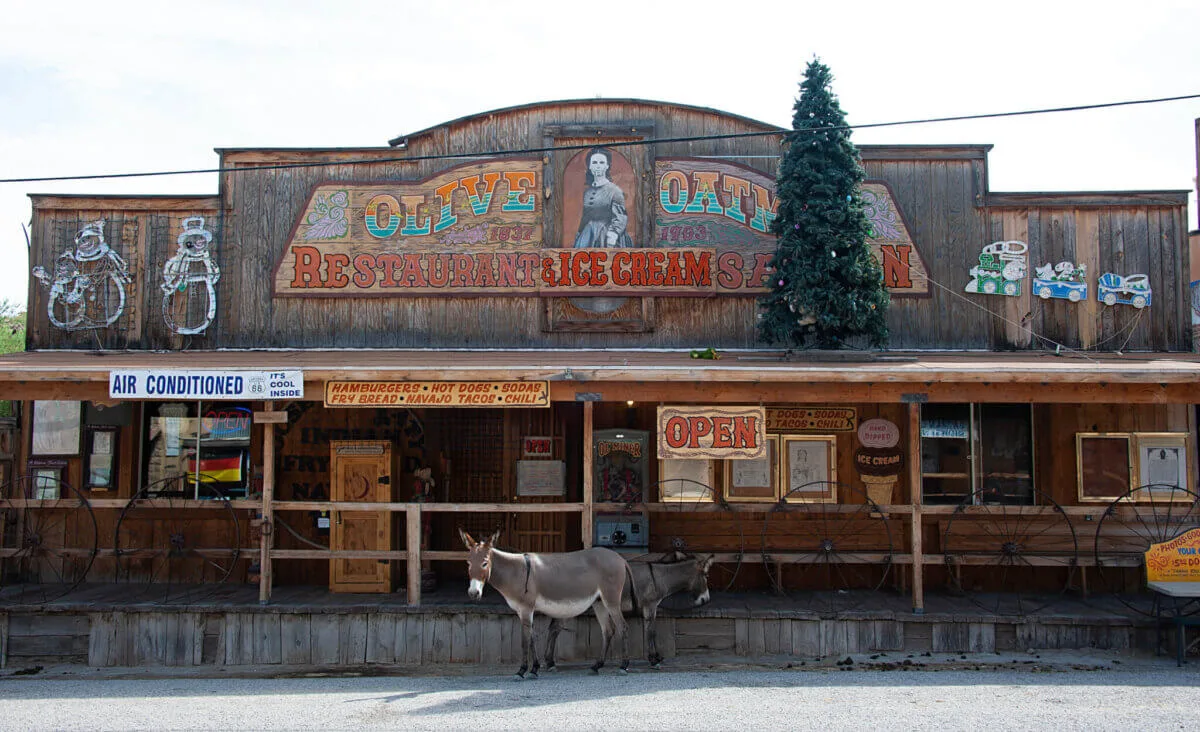
Once some of the state’s most thriving destinations, these historic towns are now picturesque relics of the past.
Arizona is a hub for historical towns. Many were built during the state’s Wild West days and prospered due to mining booms, but they eventually succumbed to desertion and dereliction. Some, such as Jerome and Bisbee, have transformed into thriving arts and tourist destinations, while others have decayed with time.
We selected seven of our favorites—from living ghost towns to desolate ruins—that are remarkable representations of the Grand Canyon State’s past.
1. Chloride

Nestled in the foothills of the Cerbat Mountains, about 30 minutes north of Kingman, Chloride is the longest continually inhabited mining town in Arizona. Founded in the 1860s when silver was discovered in the area, it now has fewer than 300 residents. In the center of town is Cyanide Springs, a rickety replica of the Old West. Built in the 1980s as a tourist attraction, it features a saloon, jail, undertaker’s office, schoolhouse, and blacksmith’s shop. Also worth a visit are the “Chloride Murals.” Painted on 2,000 square feet of boulders by acclaimed artist Roy Purcell in the 1960s, the vibrant images showcase scenes of mining and mysticism.
2. Fairbank
Just 10 miles west of Tombstone, Fairbank began as a stagecoach stop and, with the construction of a railroad, became an important depot for cattle and ore. Visitors can explore many of the original buildings, including homes, stables, a mercantile, and a schoolhouse that now serves as a museum and information center. Walk along the railroad bed to an old gravesite, or take a two-mile hike to the ruins of the Presidio Santa Cruz de Terrenate. The Spanish military fortress dates to the late 1700s. In 1986, the Bureau of Land Management acquired Fairbank and incorporated it into the San Pedro Riparian National Conservation Area, preserving the region’s desert ecosystem.
3. Lowell
Like its neighbor to the northwest, Bisbee, Lowell was once a thriving mining town. Now all that remains is its main drag, Erie Street, which is a photographer’s dream. About 20 brick storefronts, most abandoned and showcasing displays of midcentury Americana and automobilia, line both sides of the street. Classic 1950s and ’60s cars—and even an old “Strayhound” bus—sit abandoned, as if their passengers simply vanished. However, one business continues to draw in customers: Bisbee Breakfast Club serves up tasty breakfast and lunch and is a favorite of visitors and locals alike. Don’t miss the huevos rancheros.
4. Oatman

As is the case with many of Arizona’s ghost towns, this nostalgic stop on Route 66 that looks as though it stepped out of a cowboy movie got its start as a mining camp. Today, there are more burros— several thousand—in Oatman than there are people—about 100. The wild donkeys are descendants of those used by the early prospectors. Protected by federal law, they roam the streets as they please. Pick up a bag or two of burro treats that are readily available at local businesses, and you’ll have the friendly equines literally eating out of your hand.
5. Ruby
This privately owned ghost town is also one of the state’s best-preserved. Located near the Mexican border, just west of Nogales, it was once home to more than 1,200 people and the largest lead- and zinc-producing mine in Arizona. In the 1920s, the town was the site of three double homicides, known as the Ruby Murders. Self-guided tours of the more than two dozen restored buildings are available with an entrance fee. Camping and fishing permits also can be purchased. Ruby is listed on the National Register of Historic Places.
6. Tombstone

The most famous of Arizona’s mining camps, this Wild West town about an hour north of the Mexican border is known throughout the world for the 1881 gunfight at the O.K. Corral, where brothers Virgil, Morgan, and Wyatt Earp, along with Doc Holliday, took on a band of outlaws. Watch daily re-enactments of the famous shootout, tour Wyatt Earp’s house and the haunted Bird Cage Theatre, take a ride on a historic stagecoach, and explore all the history that the “Town Too Tough to Die” brings to life. Just north of the city is the 1878 Boothill Graveyard, where those shot down at the O.K. Corral are buried.
7. Two Guns

Once a popular tourist stop along Route 66, the remnants of this former trading post, store, restaurant, gas station, and zoo are now crumbling ruins just off Interstate 40, midway between Flagstaff and Winslow. Homesteaders settled here in the early 1900s, attracted to the location on the edge of Diablo Canyon. The town’s main claim to fame was a zoo, built in 1925 by an eccentric Apache named Henry “Two Guns” Miller, that housed mountain lions and other desert animals. The stone entry gate to the zoo still stands, as do the cages on the rim of the canyon. The modern-day gas station, a swimming pool, and other buildings are deserted and covered in colorful graffiti.
Want to discover more fun things to do across Arizona? Follow us on Instagram!
Politics

Trump says he’s pro-worker. His record says otherwise.
During his time on the campaign trail, Donald Trump has sought to refashion his record and image as being a pro-worker candidate—one that wants to...

VIDEO: Hundreds show up in Scottsdale to support reproductive rights
@coppercourier Days after the Arizona Supreme Court ruled to enforce a long-dormant law that bans nearly all abortions, hundreds took part in a...
Local News

US court rejects a request by tribes to block $10B energy transmission project in Arizona
In Arizona, work was halted briefly in November amid pleas by tribes to review environmental approvals for the San Pedro Valley. ALBUQUERQUE, N.M....

What to know about Trump’s legal issues
Over the past year, former president Donald Trump has become the center of not one, not two, not three, but four criminal investigations, at both...




